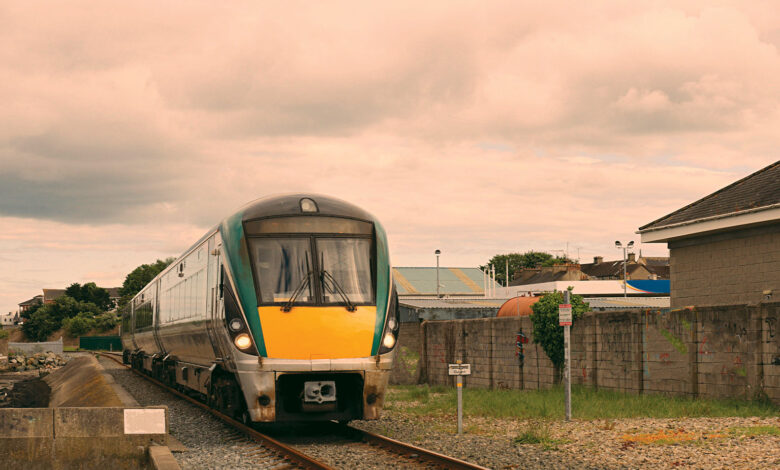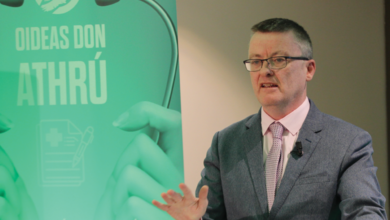
Ambitions have been set out for rail connectivity to be significantly enhanced across Ireland, with all counties, aside from County Fermanagh, set to have access within the next 25 years.
Following the return of the Northern Ireland Executive, the All-Island Strategic Rail Review has been published, one-year after being published in draft form by the Department of Transport when the Executive was suspended.
Under the proposals, rail connections are to be restored in and expanded to 31 of Ireland’s 32 counties, with a total of 32 recommendations aimed at enhancing the network across the next 25 years while making train travel quicker and more environmentally friendly.
The recommendations include:
- restoring a line linking Portadown, County Armagh with Mullingar, County Westmeath with the line passing through Armagh city and Cavan town;
- restoring a line between Derry and Portadown, linking the towns of Strabane, Omagh and Dungannon (all in County Tyrone) to the network;
- build a new direct line between Lisburn, County Antrim and Newry city;
- restoring a line between Athenry, County Galway and Claremorris, County Mayo, connecting Tuam, County Galway to the network;
- reinstating the railway south County Wexford;
- developing a new rail link from Letterkenny, County Donegal to Derry city;
- building a rail link that would cross central Dublin – potentially via a tunnel – to connect Heuston station, which receives trains from the south and west of the island, with Connolly station, which serves the north and east; and
- connecting Dublin, Shannon, and Belfast International airports to the rail network. In Dublin, the move would complement the existing plan for a MetroLink service from the airport into the city centre and would enable intercity services to access directly the island’s biggest airport. Reinstating the Lisburn to the Antrim line would enable Belfast International Airport to be served by a rail link for the first time, while in Shannon the review recommends the building of a spur to facilitate a rail link with Limerick city.
While these are all medium- to long-term ambitions, there are some proposals which are expected to go ahead in the short term, including the introduction of additional track capacity, electrification, increased speeds, and higher service frequencies on existing networks.
While the recommendations of the review have broad support, there has been some criticism at the lack of connectivity in County Donegal beyond the single line being proposed between Letterkenny and Derry, and the absence of proposed projects in County Fermanagh which would leave it as the only county in Ireland with no rail connectivity.
The North’s Minister for Infrastructure John O’Dowd MLA commented on the Fermanagh omission: “I recognise that many will be disappointed by the omission of rail connections to Fermanagh, in particular Enniskillen. Following the consultation period last year, I asked the consultants to review this, but they concluded that a new railway line did not appear to stimulate sufficient demand to support a rail service within the time frame of the review.”
Decarbonisation
While the scope of the review does not include developing a detailed decarbonisation strategy for the island’s railways, it has developed a plausible approach by drawing on insights from Great Britain’s Traction Decarbonisation Network Strategy and Denmark’s Togfunden programme, which has introduced high-speed rail travel (between 160 and 250km/h) and has significantly reduced carbon emissions since being rolled out in Denmark in 2014.
The considerations which can be considered in the medium term are:
- Electrified railways: Electric traction is proven, widely used, and supported by relatively strong supply chains. It can support passenger trains and freight trains over long distances, at high speed, and without refuelling. However, this option requires significant investment in infrastructure such as Over Head Line Equipment (OHLE). The Government is currently investing heavily in expanding OHLE for the DART service in the Dublin area, which will increase the length of electrified railway from circa 50km to 150km (around 5 per cent of the island’s railway route length).
- Battery electric trains: Battery electric trains have been proven at a relatively small scale. These are suited to operating short distances but cannot currently support higher speed (around 200km/h) passenger trains or freight trains over long distances.
- Hydrogen-powered trains: This technology is earlier in its development cycle, but the signs are stated as “promising”. Hydrogen trains have been shown to work in a live operating environment, although the economics of adopting this technology at scale are less clear. This technology could support passenger services over relatively long distances in areas with relatively easy access to hydrogen production and storage.
To enable the introduction of low-carbon rail pathways, the review states that the two administrations on the island should develop and implement an All-Island Rail Decarbonisation Strategy that, as a minimum, includes an electrified intercity network; develop plans to invest in the skills, supply chains, and rolling stock to deliver decarbonisation; and procure hybrid and electric rolling stock in the medium term.
The report estimates the capital cost of implementing all the recommendations by 2050 would be between €35 billion and €37 billion in 2023 prices, of which 75 per cent is to be funded by the Government and 25 per cent funded by the Northern Ireland Executive.
While the stated upfront cost is high, it would be spread evenly over the period of 25 years to implementation, and the report states that there would be economic benefits which would unlock a return on the investment.
“Some costs would be offset by future revenue, while others could be met by government funding. In addition, there would be other impacts arising from the delivery of some interventions, particularly during their construction,” the report states.
“These costs would represent a similar annual spend as was committed in the middle of the 2000s when Ireland expanded its motorway network, and they would be shared across both jurisdictions.”
Minister for Transport Eamon Ryan TD said: “This is not just the first All-Island Strategic Rail Review, it is the most ambitious vision for rail in a century, bringing us forward to a new age of rail.
“This vision has been made possible by close co-operation between the departments and agencies north and south.
“Rail not only allows us to carry more people and freight in a more sustainable way, it is the great connector, enabling greater regional accessibility and balanced regional development.”
Minister O’Dowd added: “This publication brings us to a new chapter where we can shape a better future for everyone by decarbonising key services and investing in climate adaptation measures, while at the same time supporting economic productivity through projects, policy and legislation.”





